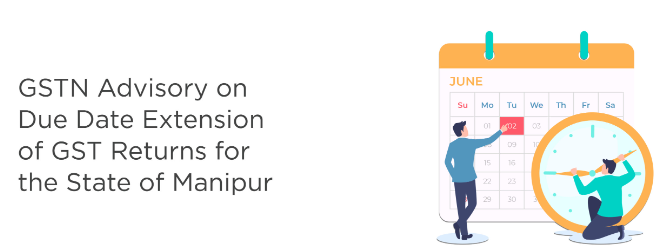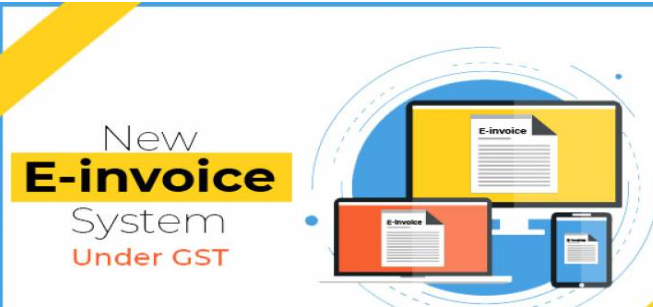
Advisory on due date extension of GST Returns for the state of Manipur
28/05/2023
- 1. Vide Notifications No. 11/2023 – Central Tax, 12/2023 – Central Tax and 13/2023 – Central Tax, all dated 24th May 2023, the Government has extended the due date of filing GSTR-1, GSTR-3B & GSTR-7 of April-2023 tax period till 31st May 2023 for all the taxpayers having principal place of business in the state of Manipur.
- 2. The said changes have been implemented on the GST Portal from 27th May 2023 onwards.
- 3. The late fee paid by the taxpayers who have filed their returns before 27th May 2023, shall be credited into their ledgers. The interest amounts, shown in the next return, if any, may be corrected by the taxpayers themselves, as it is an editable field.
Advisory on Filing of Declaration In Annexure V by Goods Transport Agency (GTA) opting to pay tax under forward charge mechanism
30/05/2023
- The GTAs, who commence business or cross registration threshold on or after 1st April, 2023, and wish to opt for payment of tax under forward charge mechanism are required to file their declaration in Annexure V for the FY 2023-24 physically before the concerned jurisdictional authority.
- The declaration may be filed within the specified time limits, as prescribed in the Notification. No. 05/2023-Central Tax (Rate), dated. 09.05.2023.

E-Invoice Verifier App by GSTN - Advisory
08/06/2023
Dear Valued Taxpayer,
1. The E-Invoice Verifier App developed by GSTN, has been introduced which offers a convenient solution for verifying e-Invoices and other related details. GSTN understands the importance of efficient and accurate e-invoice verification, and this app aims to simplify the process for your convenience.
2. E-Invoice Verifier App - Key Features and Benefits:
i. QR Code Verification: The app allows users to scan the QR code on an e-Invoice and authenticate the embedded value within the code. This helps in identifying the accuracy and authenticity of the e-Invoice.
ii. User-Friendly Interface: The app provides a user-friendly interface with intuitive navigation, making it easy for users to navigate through the app's features and functionalities.
iii. Comprehensive Coverage: The app supports verification of e-Invoices reported across all six IRPs, ensuring comprehensive coverage and convenience.
iv. Non-Login Based: The app operates on a non-login basis, meaning users are not required to create an account or provide sensitive personal information to access its functionalities. This simplifies the user experience and makes it more convenient for users.
3. How to use the e-Invoice Verifier App:
i. Download the App: Visit the Google Play Store and search for "E-Invoice QR Code Verifier." Download and install the app on your mobile device free of charge. The iOS version will be available shortly.
ii. QR Code Scanning: Utilise the app to scan the QR codes on your e-Invoices. The app will authenticate the information embedded in the code and one can compare it with information printed on the invoice.
4. GSTN emphasizes that the e-Invoice Verifier App does not require any user login or authentication process. Anyone can freely scan QR codes and view the available information.
5. For more detailed information please see the FAQs in the app. This comprehensive FAQ document will provide you with additional guidance on using the app and resolving any queries you may have.
6. GSTN is dedicated to enhancing your experience with the E-Invoice Verifier App and providing a process of seamless e-Invoice verification. GSTN is also working towards launching Version 2 with the Search IRN functionality, which will further streamline your e-Invoice verification.

Advisory: Update on Enablement Status for Taxpayers for e-Invoicing
16/06/2023
Dear Taxpayers,
It is to inform that as per Notification No. 10/2023 - Central Tax dated 10th May 2023, the threshold for e-Invoicing for B2B transactions has been lowered from 10 crores to 5 crores. This change will be applicable from 1st August 2023.
2. To this effect GSTN has enabled all eligible taxpayers with an Aggregate Annual Turnover (AATO) 5 crores and above as per GSTN records in any preceding financial year for e-Invoicing. These taxpayers are now enabled on all six IRP portals including NIC-IRP for e-Invoice reporting.
3. You can check your enablement status on the e-Invoice portal at https://einvoice.gst.gov.in .
4. It would be in the interest of trade to register and utilize the sandbox testing facility available at the IRP portals. This will help taxpayers to familiarize themselves with the invoice reporting mechanism and ensure a seamless transition to the e-Invoice system.
5. Please note that the enablement status indicated on the e-Invoice portal does not indicate a legal obligation on taxpayers to use e-Invoicing. However, actual liability to generate IRN shall be checked by taxpayers with respect to applicable notification in the light of facts pertaining to them.
6. While the listing of enabled GSTINs is purely based on the turnover criteria reported in GSTR-3B, it is essential for taxpayers to confirm whether they fulfil the conditions outlined in the notification/rules. Thus, it is the legal responsibility of the concerned taxpayer, both buyers and suppliers, to ensure compliance.
7. In case, a taxpayer who is otherwise but not auto enabled on the e-Invoice portal, can self-enable for e-Invoicing using the functionality provided on the portal.
8. GSTN once again emphasises that all eligible taxpayers should familiarize themselves with the e-Invoicing requirements and take the necessary steps to ensure compliance with the new threshold.

Advisory: Online Compliance Pertaining to Liability / Difference Appearing in R1 – R3B (DRC-01B)
29/06/2023
Dear Taxpayers,
1. It is informed that GSTN has developed a functionality to enable the taxpayer to explain the difference in GSTR-1 & 3B return online as directed by the GST Council. This feature is now live on the GST portal.
2. The functionality compares the liability declared in GSTR-1/IFF with the liability paid in GSTR-3B/3BQ for each return period. If the declared liability exceeds the paid liability by a predefined limit or the percentage difference exceeds the configurable threshold, taxpayer will receive an intimation in the form of DRC-01B.
3. Upon receiving an intimation, the taxpayer must file a response using Form DRC-01B Part B. The taxpayer has the option to either provide details of the payment made to settle the difference using Form DRC-03, or provide an explanation for the difference, or even choose a combination of both options.
4. To further help taxpayers with the functionality, a detailed manual containing the navigation details is available on the GST portal. It offers step-by-step instructions and addresses various scenarios related to the functionality. The link is stated below:
India imposes antidumping duty on 5 Chinese goods for 5 years
Dec 27, 2021
India has imposed antidumping duties on five
Chinese products, including certain aluminium goods and some chemicals, for
five years to guard local manufacturers from cheap imports from the
neighbouring country. According to separate notifications of the Central Board
of Indirect Taxes and Customs (CBIC), the duties have been imposed on certain
flat rolled products of aluminium; sodium hydrosulphite (used on dye industry);
silicone sealant (used in manufacturing of solar photovoltaic modules, and
thermal power applications); hydrofluorocarbon (HFC) component R-32; and
hydrofluorocarbon blends (both have uses in refrigeration industry).
These duties were imposed following recommendations of the commerce ministry's
investigation arm Directorate General of Trade Remedies (DGTR).
Govt hikes import duty on toys to 70%
Feb 02, 2023
The government on Wednesday increased the import
duty on toys and its components to 70 per cent with a view to cut inbound
shipments of these products and boost domestic manufacturing activities.
Similarly, import duty on bicycles has also been hiked to 35 per cent from 30
per cent, according to a Union Budget document.
Import duty hike on toys and parts of toys excludes parts of electronic toys.
Earlier, basic customs duty on toys was increased from 20 per cent to 60 per
cent in February, 2020 to promote local manufacturing.
India raises tax on imported cars, motorbikes, including EVs in a bid to boost "Make in India" scheme
Feb 02, 2023
India on Wednesday said it will raise taxes on imported
cars and motorbikes, including electric vehicles (EVs), as it seeks to boost
local manufacturing in line with Prime Minister Narendra Modi's "Make in
India" campaign ahead of elections in 2024.
All vehicles with a landed cost of less than $40,000 will be taxed at 70%, up
from 60% earlier, a move analysts say could impact demand. The landed cost
includes the vehicle's price tag plus insurance and freight costs.
Import tax on all semi-knocked-down cars - where major parts are imported
separately and the final vehicle is assembled in the country - will be raised
to 35% from 30%.
Search
Categories
Recent News
- income Tax
- Implementation of Mandatory Mentioning of HSN Codes in GSTR-1
- Advisory on Sequential Filing of GSTR-1
- Finance Minister Proposed, Common ITR form for all Taxpayers
- Finance Ministry Extends ITR Filing Deadline for Companies
- CBDT Extends Deadline for Filing TDS for Non-Salary Transactions
- Change Your Income Tax Regimes While Filing Revised ITR
- Finance Ministry say, "Taxpayers check AIS quarterly & report discrepancies"